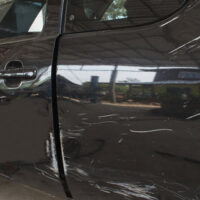Some Basics on T-Bone Collisions

Side-impact collisions/broadside collisions, commonly referred to as T-Bone collisions, are among the most dangerous types of auto accidents. A T-bone accident occurs when the front of one vehicle slams the side (left or right) of another, mostly at an intersection. Nonetheless, even though T-bone accidents are most popular at intersections, it is essential to note that they can happen anywhere.
Common Causes of T-Bone Accidents
Different negligent actions lead to T-bone accidents. The negligent acts that cause such accidents include;
- DUI
- Speeding
- Disobeying traffic signs and signals
- Failing to yield to oncoming traffic
- Distracted driving
- Aggressive driving
Usually, it takes only one negligent driver for a side-impact collision to occur. Nonetheless, cases of both drivers being guilty of negligence are not uncommon.
Common Injuries After T-Bone Collisions
T-bone collisions rarely cause minor injuries because of the severity of the side impact. Common injuries that result from T-bone collisions include;
- Head injuries, such as traumatic brain injuries.
- Chest trauma
- Broken ribs
- Cuts and lacerations
- Side-impacts, especially those involving high-speeds, often lead to fatalities.
Liability in T-Bone Collisions
For a driver to be held liable after a T-bone accident, they must be found guilty of acting in negligence. Therefore, to receive the compensation you deserve after a T-bone accident, if you played no role in causing the accident, you need to prove the accident occurred solely due to the other driver’s negligence. Suppose the other driver ran a red light and collided with your vehicle. In such a case, to receive the compensation you deserve, you will need to prove that the other driver acted negligently by running the red light and that their action was the sole reason why the accident happened.
But, what happens when you are partly to blame for an accident? For example, what would happen if the other driver failed to yield right of way, and you failed to avoid the collision because of sleep-deprived driving? Fortunately, even if you are partly to blame for a Florida T-bone collision, you can still obtain compensation. As a comparative negligence state, Florida allows motorists to receive compensation based on their degree of fault. This means that the compensation you receive when you are partly to blame for a T-bone accident, will be reduced by your percentage of fault. For example, if you are awarded $200,000 in damages, and your share of the blame is 30%, you will receive 70% of the $200,000.
Steps to Take After a T-Bone Collision
After a side-impact collision, the first thing you should do is seek medical attention as soon as possible. Even if you cannot see any physical signs of injuries, seek medical attention.
Apart from seeking medical attention, you should;
- stay calm and avoid arguing or fighting with the other driver.
- document the accident scene by taking photos, if you can.
- seek legal help.
Contact Us for Help Today
If you were recently involved in a T-bone collision, you must be going through a difficult time, considering T-bone accidents are extremely dangerous and mostly cause severe injuries. Our Jacksonville personal injury attorneys at the Pendas Law Firm can help you receive the compensation you deserve for your injuries. The experience we have allows us to fight back against cunning insurance companies and defendants. Contact us today to schedule a free, no-obligation consultation.
The Pendas Law Firm also represents clients in the Fort Myers, Tampa, Miami, Orlando, Ocala, Bradenton, Daytona Beach, West Palm Beach, and Fort Lauderdale areas.
Resource:
iihs.org/topics/fatality-statistics/detail/passenger-vehicle-occupants






